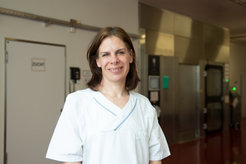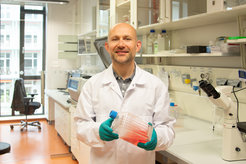At the core of the MPI: our core facilities
Bettina Bertalan and Steffen Lawo about their work as head of a core facility.
Core Facilities are exactly that, the core of many research institutions. At our institute, we are fortunate to benefit from as many as eight core facilities: Bioinformatics, Comparative Biology, CRISPR Screening, FACS & Imaging, Metabolomics, Phenotyping, Proteomics and Transgenesis make our lives easier every day. They provide state-of-the-art equipment and highly specialized expertise, thus reducing the burden on groups and scientists. Bettina Bertalan and Steffen Lawo run two of the Core Facilities and share their experiences here.

Bettina, what is your position at the institute?
Bettina: I am the head of mouse facility, "Comparative Biology". I am also the veterinarian at the Institute and work closely with our Animal Welfare Officer. I am actually also almost a founding member. I was able to help set up the MPI before it was founded, because I've been here since 2009, so I've been here for 12 years. Therefore, I know the institute before there was the first mouse.
How many employees and mice are there currently in Comparative Biology?
Bettina: In our institute, of course, we don't always have the same number of mice. When research groups leave, we also have fewer mice to take care of. Therefore, we currently have too many staff rather than too few. But I am very grateful for that, because it allows us to do our normal work very well even during the pandemic and our animals are optimally cared for.
In Comparative Biology, animal caretakers are also trained. Do you take on many of those you have trained yourself?
Bettina: We have taken on very many of them. Because it has always been very difficult to get good staff, we decided in 2010 that we would train them. It helped us to secure our own staff, we can employ the trainees as fully qualified animal caretakers directly from day 1 after they have completed their training without having to train them further. We are therefore very well networked, because the training animal facilities talk to each other a lot. As a result, I have already been sent a lot of initiative applications.
To what extent are you personally involved in the training?
Bettina: That is the job of the animal caretakers. I only train special subjects myself. This is also a form of employee development. The trainers can develop personally and keep up with the latest techniques and developments. It's a win-win situation for everyone.
Steffen, can you describe your position at the institute?

Steffen: I am the head of the "CRISPR Screening Core Facility" and started in September 2020. The core facility is set up to provide researchers with screening reagents, such as screening libraries and protocols, but otherwise they do the biggest, most time-consuming part of the screening process themselves. On the one hand, they know their systems, the cells, best and know how to deal with them, and on the other hand, it wouldn't be possible to carry out the entire screening process in the core facility. Another positive effect is that the work of the facility is not a "black box" where ultimately only data is produced, but all processes and results can be easily understood by the scientists. In the process, they receive as much assistance from me as necessary.
You previously worked in industry. What was it like working there?
Steffen: After my PhD, I was in a CRO (Contract Research Organization) i.e. a biotech service provider company in Cambridge, UK and most recently as team leader of a Functional Genomics Screening group. This role prepared me very much for leading the Core Facility, as part of my daily routine, I implemented all technical aspects of CRISPR screening. I also helped establish the CRISPR screening platform in the company, did many screens myself as a senior scientist, and helped develop new applications. As a team leader, I supervised five scientists. In addition, there were organizational tasks such as project management, customer support and team leadership.
How was the work approach different than here at MPI?
Steffen: In the CRO, the entire screening process was in our hands - from start to finish. There, you really only delivered data packages to the customer. The commercial setting helps to focus, deadlines and budgets have to be strictly adhered to. You have to try to work scientifically to the highest possible quality and at the same time be commercially profitable.
How do you compare working in a biotech company and a core facility?
Steffen: I already experienced the bigger difference when I switched from a PhD in academic research to a biotech company. That was a steep learning curve. Now I have internalized that you work to deadlines and to budgets. But I also find it very nice to work more openly in the academic context again and to be guided by science.
Bettina, what kind of service do you provide?
Bettina: We do as much as we can for the scientists. With this, we have upgraded the work of the animal caregivers. From an animal welfare perspective, this is the best concept. If you look at how animal facilities have evolved over the last 20 years, it has always been a shift away from small user-managed facilities to centrally managed facilities. It is more efficient and also much better in terms of animal welfare. However, we would be happy if we were mentioned more often in acknowledgements in publications or lectures. Sometimes it is not recognized enough how much work and know-how we have invested.
Steffen, what has been the biggest challenge so far in setting up the CRISPR Facility?
Steffen: Setting up a lab in pandemic times is accompanied by difficulties, which is clearly reflected in the delivery times and availability of materials and equipment. Communication with colleagues is much more difficult due to the situation. The spontaneity that is often needed to engage in conversation and exchange ideas is somewhat lacking. I am in the fortunate situation that before I came here there were several groups that basically knew what they wanted to do. Here at the Institute, you get all the support you need. It's challenging, but in a positive way.
What are your goals for the facility?
Steffen: The medium- to long-term goals are to see that the demand for screenings remains steady. As far as collaborations are concerned, I would of course like to see applications for screening adapted and expanded to the institute's needs, such as screening in vivo like mice or worms, or more complex cell systems like 3D cell culture or organoid screens. There, I would very much like to be guided by the interests in house.
What can you learn from the other facilities?
Steffen: I learn a lot about how to work at the institute, about budget planning, but also the collaborations with the other Core Facilities. We have regular meetings, where you hear about developments, worries and needs, but also the good bits.
Bettina, what advice would you give Steffen as an experienced Core Facility leader?
Bettina: If anything, I can learn something from Steffen. With the move to this building, there were many rules that didn't exist before. I come from the "Wild West" era. That's why I tend to look for facilities that come from the professional sector, such as in Steffen's case from the corporate sector, because he adds a whole other level of expertise. The advice is "Tomorrow everything is always different. Stay flexible."
A contribution by Britta Thewes













